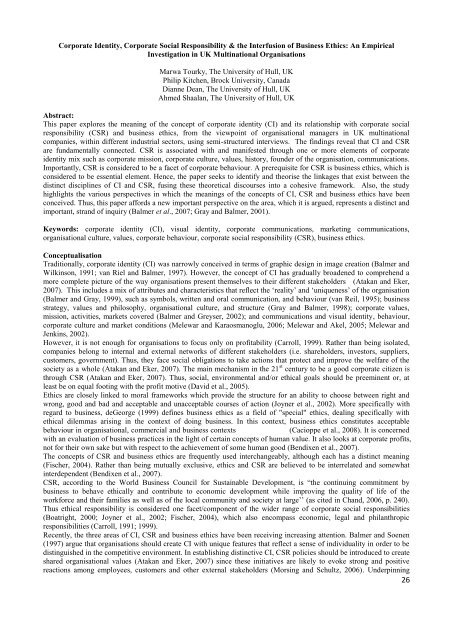Brand, Identity and Reputation: Exploring, Creating New Realities ...
Brand, Identity and Reputation: Exploring, Creating New Realities ...
Brand, Identity and Reputation: Exploring, Creating New Realities ...
Create successful ePaper yourself
Turn your PDF publications into a flip-book with our unique Google optimized e-Paper software.
Corporate <strong>Identity</strong>, Corporate Social Responsibility & the Interfusion of Business Ethics: An Empirical<br />
Investigation in UK Multinational Organisations<br />
Marwa Tourky, The University of Hull, UK<br />
Philip Kitchen, Brock University, Canada<br />
Dianne Dean, The University of Hull, UK<br />
Ahmed Shaalan, The University of Hull, UK<br />
Abstract:<br />
This paper explores the meaning of the concept of corporate identity (CI) <strong>and</strong> its relationship with corporate social<br />
responsibility (CSR) <strong>and</strong> business ethics, from the viewpoint of organisational managers in UK multinational<br />
companies, within different industrial sectors, using semi-structured interviews. The findings reveal that CI <strong>and</strong> CSR<br />
are fundamentally connected. CSR is associated with <strong>and</strong> manifested through one or more elements of corporate<br />
identity mix such as corporate mission, corporate culture, values, history, founder of the organisation, communications.<br />
Importantly, CSR is considered to be a facet of corporate behaviour. A prerequisite for CSR is business ethics, which is<br />
considered to be essential element. Hence, the paper seeks to identify <strong>and</strong> theorise the linkages that exist between the<br />
distinct disciplines of CI <strong>and</strong> CSR, fusing these theoretical discourses into a cohesive framework. Also, the study<br />
highlights the various perspectives in which the meanings of the concepts of CI, CSR <strong>and</strong> business ethics have been<br />
conceived. Thus, this paper affords a new important perspective on the area, which it is argued, represents a distinct <strong>and</strong><br />
important, str<strong>and</strong> of inquiry (Balmer et al., 2007; Gray <strong>and</strong> Balmer, 2001).<br />
Keywords: corporate identity (CI), visual identity, corporate communications, marketing communications,<br />
organisational culture, values, corporate behaviour, corporate social responsibility (CSR), business ethics.<br />
Conceptualisation<br />
Traditionally, corporate identity (CI) was narrowly conceived in terms of graphic design in image creation (Balmer <strong>and</strong><br />
Wilkinson, 1991; van Riel <strong>and</strong> Balmer, 1997). However, the concept of CI has gradually broadened to comprehend a<br />
more complete picture of the way organisations present themselves to their different stakeholders (Atakan <strong>and</strong> Eker,<br />
2007). This includes a mix of attributes <strong>and</strong> characteristics that reflect the ‗reality‘ <strong>and</strong> ‗uniqueness‘ of the organisation<br />
(Balmer <strong>and</strong> Gray, 1999), such as symbols, written <strong>and</strong> oral communication, <strong>and</strong> behaviour (van Reil, 1995); business<br />
strategy, values <strong>and</strong> philosophy, organisational culture, <strong>and</strong> structure (Gray <strong>and</strong> Balmer, 1998); corporate values,<br />
mission, activities, markets covered (Balmer <strong>and</strong> Greyser, 2002); <strong>and</strong> communications <strong>and</strong> visual identity, behaviour,<br />
corporate culture <strong>and</strong> market conditions (Melewar <strong>and</strong> Karaosmanoglu, 2006; Melewar <strong>and</strong> Akel, 2005; Melewar <strong>and</strong><br />
Jenkins, 2002).<br />
However, it is not enough for organisations to focus only on profitability (Carroll, 1999). Rather than being isolated,<br />
companies belong to internal <strong>and</strong> external networks of different stakeholders (i.e. shareholders, investors, suppliers,<br />
customers, government). Thus, they face social obligations to take actions that protect <strong>and</strong> improve the welfare of the<br />
society as a whole (Atakan <strong>and</strong> Eker, 2007). The main mechanism in the 21<br />
26<br />
st century to be a good corporate citizen is<br />
through CSR (Atakan <strong>and</strong> Eker, 2007). Thus, social, environmental <strong>and</strong>/or ethical goals should be preeminent or, at<br />
least be on equal footing with the profit motive (David et al., 2005).<br />
Ethics are closely linked to moral frameworks which provide the structure for an ability to choose between right <strong>and</strong><br />
wrong, good <strong>and</strong> bad <strong>and</strong> acceptable <strong>and</strong> unacceptable courses of action (Joyner et al., 2002). More specifically with<br />
regard to business, deGeorge (1999) defines business ethics as a field of "special" ethics, dealing specifically with<br />
ethical dilemmas arising in the context of doing business. In this context, business ethics constitutes acceptable<br />
behaviour in organisational, commercial <strong>and</strong> business contexts (Cacioppe et al., 2008). It is concerned<br />
with an evaluation of business practices in the light of certain concepts of human value. It also looks at corporate profits,<br />
not for their own sake but with respect to the achievement of some human good (Bendixen et al., 2007).<br />
The concepts of CSR <strong>and</strong> business ethics are frequently used interchangeably, although each has a distinct meaning<br />
(Fischer, 2004). Rather than being mutually exclusive, ethics <strong>and</strong> CSR are believed to be interrelated <strong>and</strong> somewhat<br />
interdependent (Bendixen et al., 2007).<br />
CSR, according to the World Business Council for Sustainable Development, is ―the continuing commitment by<br />
business to behave ethically <strong>and</strong> contribute to economic development while improving the quality of life of the<br />
workforce <strong>and</strong> their families as well as of the local community <strong>and</strong> society at large‘‘ (as cited in Ch<strong>and</strong>, 2006, p. 240).<br />
Thus ethical responsibility is considered one facet/component of the wider range of corporate social responsibilities<br />
(Boatright, 2000; Joyner et al., 2002; Fischer, 2004), which also encompass economic, legal <strong>and</strong> philanthropic<br />
responsibilities (Carroll, 1991; 1999).<br />
Recently, the three areas of CI, CSR <strong>and</strong> business ethics have been receiving increasing attention. Balmer <strong>and</strong> Soenen<br />
(1997) argue that organisations should create CI with unique features that reflect a sense of individuality in order to be<br />
distinguished in the competitive environment. In establishing distinctive CI, CSR policies should be introduced to create<br />
shared organisational values (Atakan <strong>and</strong> Eker, 2007) since these initiatives are likely to evoke strong <strong>and</strong> positive<br />
reactions among employees, customers <strong>and</strong> other external stakeholders (Morsing <strong>and</strong> Schultz, 2006). Underpinning
















